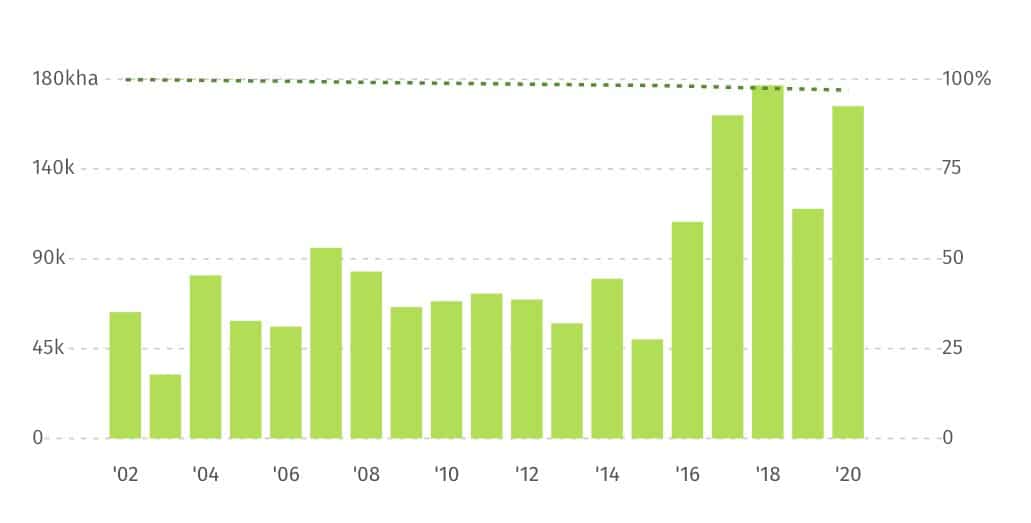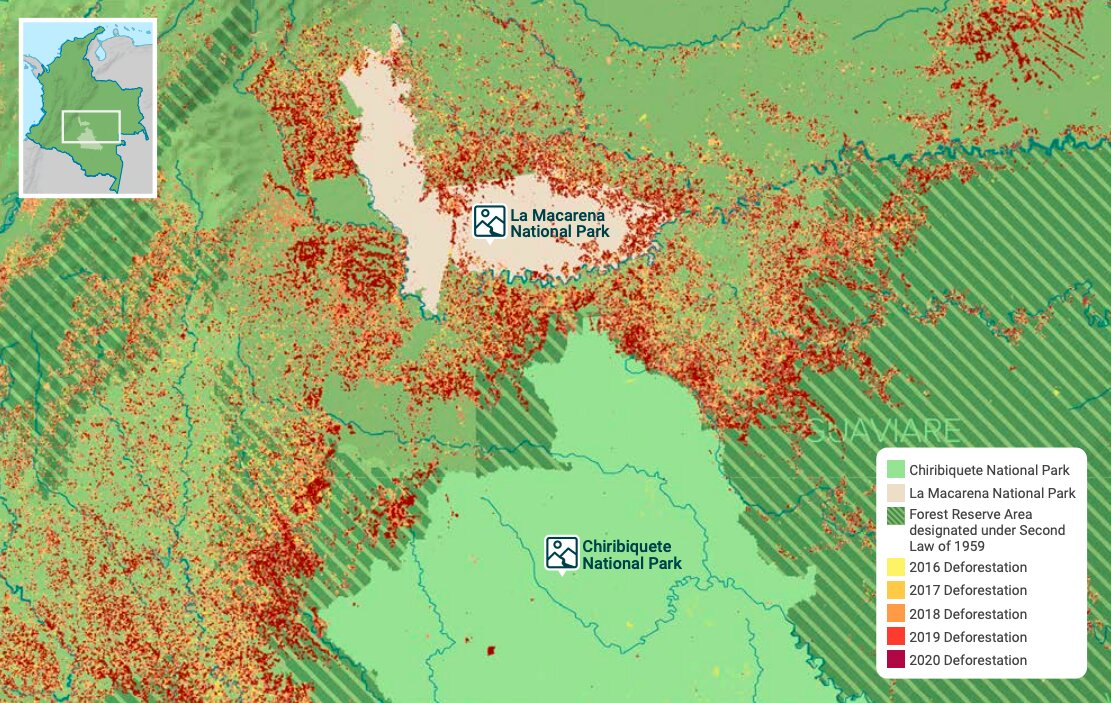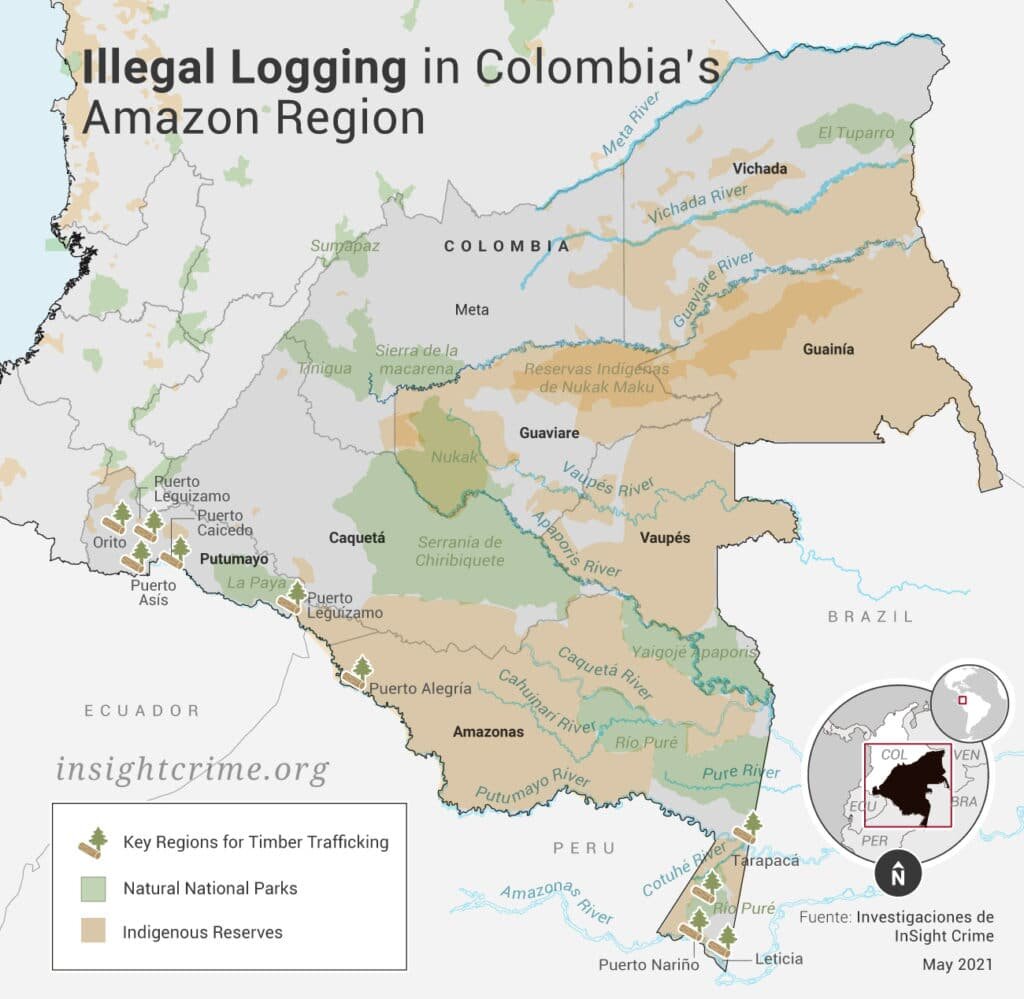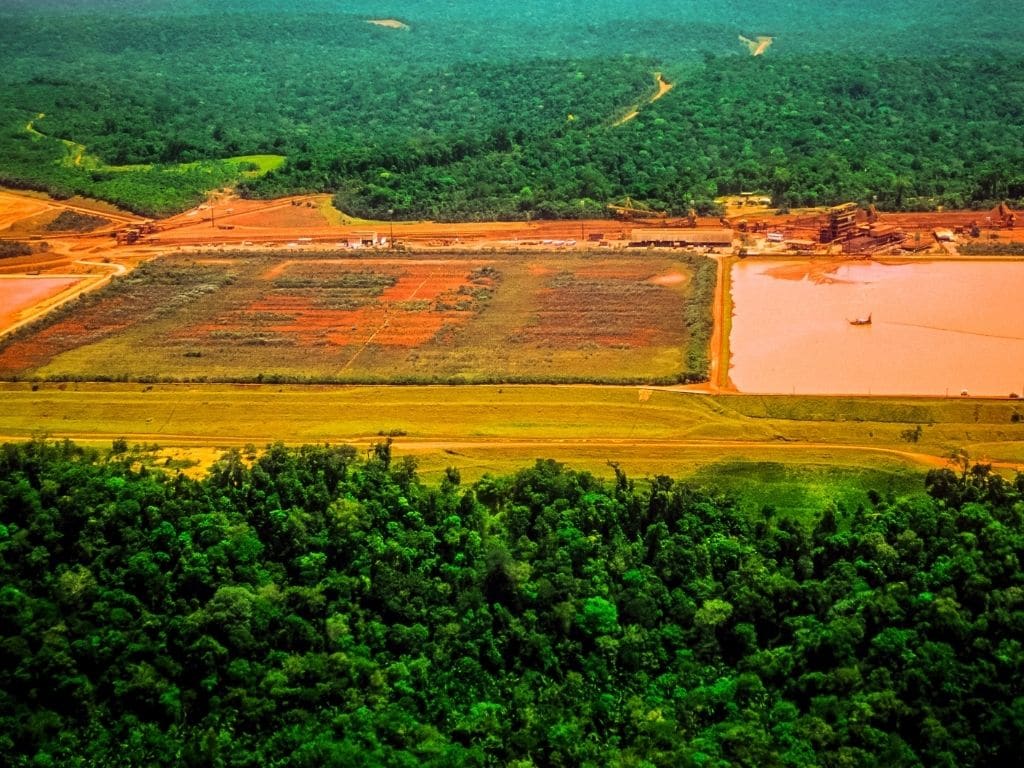The loss of forests in Colombia is an intricate story of conflict, mismanagement, and illegal activities. For decades, reckless human actions have contributed to the destruction of the country’s forests, one of its most important resources. Today, cattle ranching, coca cultivation, and gold mining are big money-makers for the rebel groups that took over the country’s green areas since the 2016 peace deal that put an end to decades of civil war. Despite more than half of the territory being covered in trees, deforestation in Colombia is making the nation more vulnerable to climate change and contributing to the impoverishment of its people.
—
Deforestation in Colombia: The Numbers
About 55% of Colombia is forested, covered by two main rainforests: the Amazon and the Chocó. The first one – spanning nine South American countries, although most of it is contained within the borders of Brazil – is one of the world’s most biodiverse places, home to over 3 million animals and over 2,500 plant species. And if it is left standing, it can generate an estimated US$8.2 billion in annual revenue, a study found. However, mainly due to reckless politics from Brazil’s president and climate denier Jair Bolsonaro, deforestation rates in the world’s green lung have hit record-high levels in recent years. Despite being much smaller, the Chocó-Darién moist forest has extremely rich biodiversity and for this reason, it is classified as one of the 25 global biodiversity hotspots prioritised for conservation. This global ecoregion, which extends along the Pacific coast of Colombia and north into Panama along the Caribbean coast, has been suffering some of the highest deforestation levels ever recorded.
Between 2002 and 2020, Colombia was losing green coverage at an unprecedented rate. 1.66 million hectares of the total 4.7-million-hectare tree cover loss experienced in nearly two decades were humid primary forests, the world’s most biodiverse and carbon-dense green areas. More than half of deforestation occurred in Colombia’s Amazon region, which covers approximately 10% of the country’s total territory.

Primary Forest Loss in Colombia, 2002-2020. Image: Global Forest Watch.
We take a closer look at the main drivers of deforestation in Colombia and its destructive effects on the environment, the country’s biodiversity, and Indigenous communities.
You might also like: Deforestation in Southeast Asia: Causes and Solutions
The Main Drivers of Deforestation in Colombia
After decades of brutal civil war, a peace agreement was signed in 2016 between the Colombian government and the Revolutionary Armed Forces of Colombia (FARC). Since then, deforestation has skyrocketed. Indeed, in the run-up to peace, strict controls enacted by FARC to protect forests for strategic reasons were suddenly relaxed as the guerrilla group left the area, prompting a scramble for resources among farmers, miners, and loggers and a 44% increase in deforestation and land grabbing. New illegal and less organised dissident groups replaced FARC almost immediately and they have been holding sway in some parts of the rainforest ever since. While Colombia’s People’s Army used canopy cover as a protection from foreign attacks, these new armed groups are considerably smaller and have no incentive to preserve forests as they do not need protection.
In 2017 – the year after the peace deal was signed – the number of trees cut down in Colombia accounted for 2.6% of the global deforestation. In 2020, the country lost nearly 171,000 hectares of forest, an area twice the size of New York City and 8% more than the year prior. Freed from controls and protection laws, people started cutting down trees for illegal mining, logging, cocoa farming as well as cattle ranching – Colombia’s main income stream. This business alone contributed to 1.4% of the gross national product (GNP) and 21.8% of the agricultural GNP in 2017.
Land grabbing is considered a major structural cause of deforestation in the Northwestern Amazon, as it encourages land-use change to make spaces for extensive cattle ranching. Beef and veal consumption in Colombia is on the rise and it is expected to reach 11.84kg per capita by 2028. In order to satisfy the country’s insatiable demand for red meat, Colombia expanded its production quite extensively in recent years. It now has more than 500,000 sites devoted to livestock raising as well as approximately 23.4 million heads of cattle. Because of limited space availability, people have started clearing land in protected areas such as the Chiribiquete National Park, a UNESCO World Heritage Site comprising more than 4 million hectares of land in the Colombian Amazon. Here, an investigation from the Environmental Investigation Agency (EIA) found that illegal cattle production has increased threefold since 2015, with the cattle population increasing by a staggering 349% between 2016 and 2019. Within four years, nearly 17,000 hectares of forest have been cleared in the Forest Reserve Area surrounding the North and Northeast of Chiribiquete National Park.

Deforestation in Northern Area of Chiribiquete and La Macarena National Parks, 2016-2020. Image: EIA.
Among the main causes of deforestation in Colombia is illegal crop cultivation, which feeds international cocaine pipelines. Swathes of forests are unlawfully cleared every year to make space for coca plantations – which cover nearly 154,000 hectares of land. This crop is infamously known for its detrimental environmental impact as the chemicals used to process the drugs – such as gasoline and sulfuric acid – are heavily toxic and contribute to polluting rivers across the region.
Another main driver is logging for timber, most of which is done illegally in protected and often remote areas where anti-deforestation laws imposed by the government in recent years are hard to enforce. The unlawful extraction, transportation, and trafficking of protected species of wood to thriving international markets account for nearly 10% of the country’s total forest loss. Some 186 types of timber found in Colombia’s Amazon are illegally or legally sold, yet most revenues stem from only nine coveted tree species.

Logging in Colombia, 2021. Image: Insight Crime.
Other lucrative businesses are also often linked to deforestation. One of them is mining operations for gold, of which Colombia is one of the world’s largest exporters. However, most gold mining in the country is illegal and strongly connected to land degradation and waterway contamination, especially in the Chocó rainforest. Land conversion also occurs to make space for profitable extractive industries such as natural gas and oil. The latter is the country’s primary export. Despite crude oil exports declining since 2014, in 2020 Colombia exported nearly US$7.5 billion worth of crude petroleum to the United States, China, Panama, India, and Saint Lucia in the eastern Caribbean Sea.
Colombia is also the fourth-largest producer of palm oil and by far the biggest in the Western Hemisphere. The lucrative market encouraged the expansion of large-scale plantations, especially in the coastal lowland forests of the Chocó province. The unprecedented expansion of the palm oil supply chain has exploited thousands of Indigenous people from these areas, generating protests and suffering among local communities despite the government’s promises of post-conflict sustainable development and zero deforestation.
How is the Government Tackling Deforestation?
Once the world’s largest and most important carbon sinks, rainforests are being destroyed at unsustainable rates and the countries they occupy are paying the highest price. Deforestation in Colombia harms the country’s environment, biodiversity and Indigenous communities. To make up for the increase in net emissions deriving from the destruction of Brazil’s and Colombia’s forests, both countries would have to retire 80% of their vehicles, according to a study by the World Resources Institute (WRI) and Climate Focus. Furthermore, what is considered the most biodiverse country in the world is now losing many of its unique animal and plant species. Of the 3,429 known species of amphibians, birds, mammals, and reptiles that live in Colombia – one-fifth of which are endemic, meaning they cannot be found anywhere else in the world – more than 10% are threatened.
In 2020, President Iván Duque signed the Pledge for Nature at the United Nations Summit on Biodiversity along with other 92 nations. One year later, at COP26 Climate Summit, more than 110 countries including Colombia signed the Glasgow Leaders’ Declaration on Forest and Land Use, committing to end and reverse deforestation by 2030 and pledging to reinforce the rights of Indigenous communities. On this occasion, Duque promised to turn 30% of the country’s land into protected areas by the end of his administration in the summer of 2022. While signing these deals certainly sent a positive signal about the government’s ambition and willingness to step up efforts in the fight against climate change, data shows that Colombia still has a long way to go to fulfil its ambitions. In recent years, the government has brought forward multiple sustainable projects to preserve the pristine rainforest, stop deforestation and tackle climate change. One of the main countries investing in these projects – which range from green energy and transport to sustainable livelihoods and climate policy projects – is the United Kingdom. To curb escalating rates of deforestation in the country, the government even implemented programmes to reward farmers with financial incentives in a bid to stop them from cutting down trees. However, the amount of money offered to them is often extremely low and many landowners do not think it is worth giving up their land for.
Despite all these efforts, effective law enforcement – a crucial component of environmental reforms – is still lacking in the country, which is battered by corruption. On multiple occasions, international organisations have rebuked Colombian politicians for allowing environmental crimes to be committed with impunity. Furthermore, ranches across the country are protected by authorities who often turn a blind eye to illegal deforestation, such in the case of the Chiribiquete National Park. Lastly, despite the government’s efforts, legislations are often hard to enforce in remote areas, making it more difficult for authorities to exercise their power.
There is no doubt that Colombia needs more vigorous governmental action if it wants to reverse this destructive trend and keep its promise to stop deforestation by 2030. With elections looming, the country’s best hope to change the situation is electing a president with a strong plan to protect the environment, safeguard biodiversity and promote the energy transition.
You might also like: How Colombia’s President is Ignoring the Climate Crisis


















